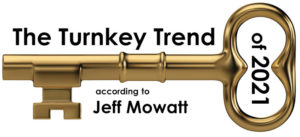Trusted Advisor Customer Service Blog Posts
Written By Jeff Mowatt – (all original content not AI generated)
Written By Jeff Mowatt – (all original content not AI generated)
Motivating your employees can be this easy
You’ve heard the expression: Give someone a fish, feed them for a day. Teach them how to fish, and feed them for a lifetime. Turns out this ‘wisdom’ violates human nature. Most people don’t want to be taught how to fish, we’d rather be given fish every day.
By the same principle, having been in the business of training teams for the last 29 years, I’ve discovered that most leaders would rather not have to learn how to train and motivate their team members. Most leaders would rather be given a turnkey system to strengthen internal and external customer relationships, along with the actual training content that they can pass along to their teams.
That’s exactly what you’ll be receiving at my upcoming live-stream seminar for leaders. Plus, this turnkey system holds employees accountable for implementing the practices. Check it out at Leading a Customer-Focused Team
The one thing managers say they should be doing more
“I should be doing more to recognize and reward my team members.” This is one of the most common comments I hear from managers who are bringing me via zoom to train their employees. Most progressive leaders realize their team members could use more encouragement and guidance. It’s just that managers themselves are so focused on operational challenges that employee recognition and training gets set aside.
The problem is now more than ever, employees need the fulfillment and gratification that comes from learning and being appreciated.
The good news is there is a simple system for ensuring employees continue to learn and feel valued. Even better for managers - it costs virtually nothing and only takes 90 minutes per month. You’ll discover this turnkey system in my upcoming live-stream seminar for managers and supervisors at Leading a Customer-Focused Team
What Customers Want – the next big trend
 As a customer yourself, see if you can relate to this kind of buying decision. It may change the services you offer to your customers.
As a customer yourself, see if you can relate to this kind of buying decision. It may change the services you offer to your customers.
I’m getting more clients requesting that I do virtual seminars, prompting me to source a higher-end studio camera that will blur my background better than the Zoom Meetings effect. I watch several YouTube videos where professional videographers explain the settings they use on their commercial equipment to get the ‘bokeh’ effect I’m looking for. I quickly come to 4 conclusions:
- I’ll have to spend real money to buy the kind of equipment that will achieve this.
- I have no desire to shop for equipment when I don’t know one camera or lens from the next.
- I know that I don’t know photography, and this is way outside my skill set.
- I know I don’t want to learn photography. I just want to enhance my virtual seminars.
Good news is a professional speaking colleague tells me about a guy who is an audiovisual tech/ professional photographer who set up her studio for a fee. I hired Brian Haig and he sources the equipment (even some of it on Kijiji) sets up my studio, adjusts all the lights and leaves me with a turnkey solution that I know sets me apart in the marketplace.
The lesson. A certain amount of your customers don’t want to be taught how-to’s. They don’t want to read manuals or take a course. They will happily pay a premium to someone they trust to do/ arrange the whole thing for them. With the massive amount of choices in almost every category of products or services, I predict this kind of turnkey service is only going to grow. Are there opportunities for you and your organization to provide more turnkey services for your customers?
Two-minute test to see if your job is vulnerable
Amazon is a perfect example of the business principle that,those companies who are the most customer-focused will dominate and disrupt the market. So, how customer-focused is your organization? Take for example how you identify and adapt to your customers’ changing needs and service expectations.
Virtually all companies respond to customer complaints, as does yours, no doubt. On top of that, many go further and proactively ask for feedback. The problem is for most organizations, any customer feedback goes to managers, but there is no system in place for everyone learning from that feedback and more importantly, adapting to that customer intel. So realistically, most organizations are no more customer-focused than their competitors. That means it only takes one company in that market – like Amazon, Uber, Netflix did in their markets - to disrupt and dominate the competition and put their competitors’ jobs in jeopardy. Remember Blockbuster?
The good news is there is a simple, zero-cost system for ensuring that as a manager you can have your team proactively gain, learn from, and adapt to your customers’ changing needs and service expectations. And it only takes 90 minutes a month. That means increasing the probability of your company disrupting your market instead of becoming displaced by a competitor who seems to come from nowhere. You’ll discover this turnkey system in my upcoming live-stream seminar. Check it out a Leading a Customer-Focused Team.
Are you trying to juggle too much?
If you’re a busy manager, which of the following activities do you find it most difficult to find time for:
- Coaching employees to enhance their service and selling skills.
- Recognizing and rewarding team members who provide exceptional internal and external customer service.
- Ensuring your team is innovating and adapting to your customers’ changing needs.
If you don’t work in a huge organization, then you likely don’t have the luxury of having an HR department that takes care of staff training and employee recognition. Nor do you have or a dedicated R&D department. You’re responsible for all of it, so these tasks typically are only done on a sporadic basis, if at all. Yet they are vital to any organization’s long-term competitiveness.
The good news is there is simple way to ensure that as a manager you address all these issues in a systematic fashion. Better yet it only takes 90 minutes a month. You’ll discover this turnkey system in my upcoming live-stream seminar. Check it out at Leading a Customer-Focused Team.
Ever receive this silly question from a cashier?
 Are you as baffled by this ‘customer service’ behavior as me? You’re in a big box store searching for a specific item or an employee to assist you. Finally, you take whatever you managed to find on your own to the front cashier where the clerk cheerfully asks, “Did you find everything you were looking for?” When I’ve made the mistake of replying “no”, they are completely at a loss. There’s a line-up behind me which cannot and should not be abandoned by the cashier to try to resolve this. So, the question is pointless. And it reminds the customer of their less than satisfactory experience - making the bad experience worse.
Are you as baffled by this ‘customer service’ behavior as me? You’re in a big box store searching for a specific item or an employee to assist you. Finally, you take whatever you managed to find on your own to the front cashier where the clerk cheerfully asks, “Did you find everything you were looking for?” When I’ve made the mistake of replying “no”, they are completely at a loss. There’s a line-up behind me which cannot and should not be abandoned by the cashier to try to resolve this. So, the question is pointless. And it reminds the customer of their less than satisfactory experience - making the bad experience worse.
Asking customers if they’ve found what they are looking for is a good question to ask of those still actively looking. But for customers who are paying at the register, retailers would be better off thanking customers for their business. They should also bid those customers a fond farewell. Because unfortunately, that experience is encouraging customers to avoid the store in future and buy elsewhere online.
3 Reasons to Stop Worrying about your Industry Competitors
 If you’re a manager or business owner of a company that sells business-to-business, you may not be as worried about being competitively blindsided as those who sell business-to-consumer. After all, if you’re not a retailer or a taxi company then one might assume you needn’t worry about market disrupters like Amazon and Uber. The problem is your business customers - when they are away from work - are experiencing remarkable convenience from those brand-busting companies. So, when those customers do work with you, they may be wondering:
If you’re a manager or business owner of a company that sells business-to-business, you may not be as worried about being competitively blindsided as those who sell business-to-consumer. After all, if you’re not a retailer or a taxi company then one might assume you needn’t worry about market disrupters like Amazon and Uber. The problem is your business customers - when they are away from work - are experiencing remarkable convenience from those brand-busting companies. So, when those customers do work with you, they may be wondering:
Why no instant ordering online? If for example, you sell plumbing supplies online to contractors, is your online ordering as easy as Amazon, where one click does it all? Or do you force regular customers to fill in numerous fields?
Why don’t I know exactly when the service person will show up? If you provide industrial services for commercial buildings, can the property manager have a mapping app like Uber that tells them exactly when your rep will arrive on-site?
Why can’t I get answers after business hours? Chatbots using AI are commonplace with consumer brands. Perhaps your brand is so specialized there aren’t many frequently asked questions. But with traditional 9-5 working hours disappearing, is there at least a live person who is receiving after-hours web requests who could potentially get back to the customer right away?
A lot of companies claim they provide great customer service. Compared to who? Your customers are no longer merely comparing you to your competitors. They’re also comparing your company to the Amazons and Ubers of the world. Is there room for improvement in your service?
The #1 Customer Turnoff – (it’s not high prices)
 Have your team members ever complained that your prices are too high to be competitive? My experience in training literally hundreds of sales and service teams over the years is that high prices are not usually the problem. Most people don’t buy based on price alone. If price were the only factor, we’d all live in the cheapest homes, drive the cheapest vehicles and only buy fast food. Our surveys revealed the #1 turnoff for most potential customers is actually the company reps themselves.
Have your team members ever complained that your prices are too high to be competitive? My experience in training literally hundreds of sales and service teams over the years is that high prices are not usually the problem. Most people don’t buy based on price alone. If price were the only factor, we’d all live in the cheapest homes, drive the cheapest vehicles and only buy fast food. Our surveys revealed the #1 turnoff for most potential customers is actually the company reps themselves.
It's not that the reps aren’t smart or friendly. On the contrary, I’m usually brought in to provide in-person or virtual training for experienced team members who have extensive product knowledge and good people skills. However, they haven’t been trained on making subtle word choices that earn more trust. Consider asking a customer, “Would you like to… (have a conversation)?” or “Do you want to…” That wording makes it easy for customers to say no, since having meetings isn’t something that busy people relish. Contrast that phrasing to, “Are you open to…” Most people like to think of themselves as being open-minded. That wording invites customers to at least consider a first step.
Bottom line – your prices may not be turning off your customers. It’s more likely your team’s word choices.
Getting past the customer Friend Zone
 At one of my trusted advisor customer service seminars, Gail, a participant who works in a credit union, asked, “How can I be taken more seriously by customers who I know outside of work as friends?” We’d been discussing the importance of growing customer relationships to the point where they see you – not as friend per se – but as a trusted advisor. During the virtual seminar, I pointed out that your customers already have their own friends, and they’re free. Occasionally, friends even expect a friends & family discount.
At one of my trusted advisor customer service seminars, Gail, a participant who works in a credit union, asked, “How can I be taken more seriously by customers who I know outside of work as friends?” We’d been discussing the importance of growing customer relationships to the point where they see you – not as friend per se – but as a trusted advisor. During the virtual seminar, I pointed out that your customers already have their own friends, and they’re free. Occasionally, friends even expect a friends & family discount.
Conversely, when customers perceive you as being their trusted advisor, your prices become less relevant, and the enhanced respect they have for you makes them more likely to recommend you. Gail’s challenge was she lives in a small community and she knows most of her customers on a personal level. I offered to Gail, “Next time customers call or stop in at your branch, you’ll of course still chat with them as friends. Then at some point transition to, ‘Ok, I need to put on my financial hat and see what I can assist you with today.’”
The line, “I need to put on my (job title) hat…” is a subtle way to let the customer know that you’re now moving into your work role. It’s a reminder that, in addition to being a nice person, you’re also a professional. Now, you’re in a position to get beyond chit-chat and towards doing more business.
The Secret Sauce to Gaining and Keeping Customers
 Have you noticed this disturbing trend in customer service? We tend to be increasingly reactive to customers, and in doing so become less respected by customers.
Have you noticed this disturbing trend in customer service? We tend to be increasingly reactive to customers, and in doing so become less respected by customers.
I blame social media algorithms that fuel our addiction to keep scrolling. That same scrolling/discarding/swiping habit crosses over into blasting through emails – just answer and delete. We’re so busy mindlessly reacting and responding to customer issues, that we don’t put the effort into getting ahead of our customer. Keep in mind I’m referring to the way we react to both external customers and internal coworkers. The good news is this is an opportunity to significantly differentiate your service.
I’ve shared in my seminars the concept of getting ahead of customers. Think of it as the secret sauce to gaining and keeping customers. It’s answering your customers’ next unasked questions and anticipating and fulfilling their next unexpressed need. By getting ahead of your customers you appear to be thinking at a higher level than customers themselves. That earns instant respect and elevates your status in your customers’ mind to trusted advisor. Your service is seen as value-added, and your price becomes less relevant. It doesn’t happen if we simply respond and react to customer requests.

